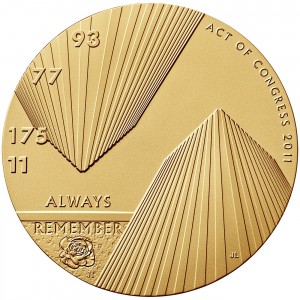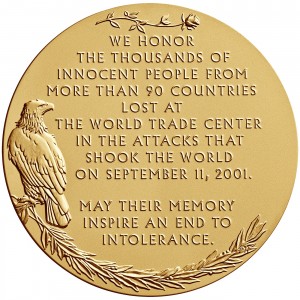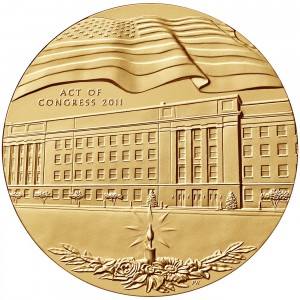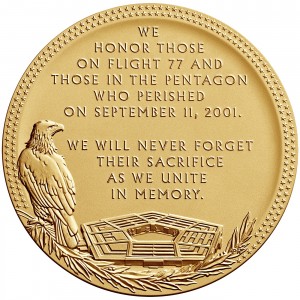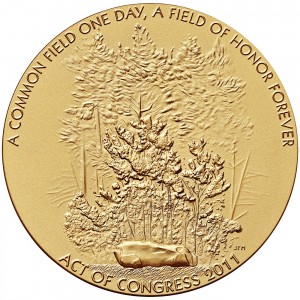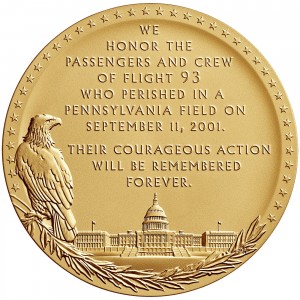Weekly World Numismatic News for January 24, 2021
 On Wednesday, Joseph R. Biden Jr. became the 46th President of the United States. It was the 46th time since 1789 that a new President took the oath of office. Regardless of the circumstances leading up to the inauguration, this was the 59th ceremonial inauguration. There were eight other inaugurations following the death of presidents and Gerald Ford’s inauguration following Richard M. Nixon’s resignation.
On Wednesday, Joseph R. Biden Jr. became the 46th President of the United States. It was the 46th time since 1789 that a new President took the oath of office. Regardless of the circumstances leading up to the inauguration, this was the 59th ceremonial inauguration. There were eight other inaugurations following the death of presidents and Gerald Ford’s inauguration following Richard M. Nixon’s resignation.
For numismatics, the new administration means there will be leadership changes at the Department of the Treasury. The president nominated Janet Yellen as the Secretary of the Treasury. When confirmed, Yellen will become the 78th Treasury Secretary. The Series 2021 Federal Reserve Notes will feature Yellen’s signature on the right side.
The president has not nominated a Treasurer of the United States. Currently, the office has been vacant since the resignation of Jovita Carranza in January 2020. When the Senate approves a nominee, that person’s signature will appear on the Federal Reserve Notes’ left side.
Officially, the Director of the U.S. Mint is an appointment of five years. David J. Ryder, the current director, was confirmed in April 2018. Ryder can serve until 2023. Although Ryder could have resigned at the end of the previous administration, he chose not to. It is unclear if Ryder, a Republican, will continue to serve as Director. The U.S. Mint’s press office responded to a question about Ryder’s plans:
Finally, the Director of the Bureau of Engraving and Printing is not an appointed position. BEP’s Directors are members of the government’s Senior Executive Service as career government employees. Len Olijar is the current and 25th Director of the Bureau of Engraving and Printing.
And now the news…
 → Read more at 9news.com.au
→ Read more at 9news.com.au
 → Read more at cnn.com
→ Read more at cnn.com
 → Read more at wgbh.org
→ Read more at wgbh.org
 → Read more at qrius.com
→ Read more at qrius.com
 → Read more at aljazeera.com
→ Read more at aljazeera.com
 → Read more at boingboing.net
→ Read more at boingboing.net
As gold falls so will U.S. Mint prices
If you have not seen what has been going on in the gold market, the prices have been falling. The financial press has not provided a single reason as to why the gold market is going down but there is a consistent view that the United States economy showing strength with unemployment dropping and low inflation may be alleviating fears in the markets. Stocks are rising and it is suspected that investors are selling their gold shares in order to participate in the bull market.
For collectors it means that the U.S. Mint could adjust the prices of precious metal products. In particular, the price is coming down that could affect the price of the Kennedy gold half-dollar. Based on the table published in the Federal Register [PDF], if the London Fix price of gold falls below $1,250 per troy ounce, the price of the coin will drop to $1,202.50 or $37.50 below the $1,240 issue price.
The London Fix is now managed by The London Bullion Market Association. Gold prices are set by an auction that takes place twice daily by the London Gold Fixing Company at 10:30 AM and 3:00 PM London time. Auctions are conducted in U.S. dollars. The benchmark used by the U.S. Mint is the PM Fix price on Wednesday.
On September 10, 2014, the London PM Fix was $1,251.00 which will leave the price of the Kennedy gold half-dollar $1,240.
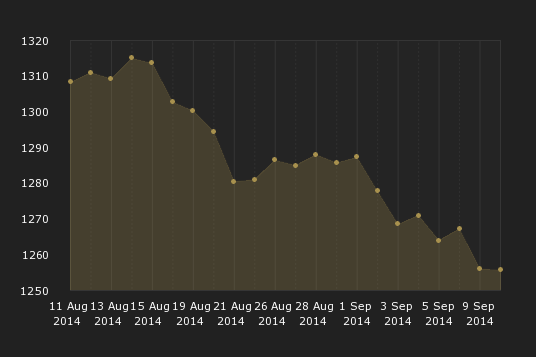
London PM Gold Fix for the month leading up to September 10, 2014
London PM Fix on September 10 was $1,251.00
Prices are in U.S. dollars
A strong economy is good for many reasons. In this case, when the price of gold drops the price of gold coins also drops. While this is not good for investors, it benefits collectors who will buy one or two coins for their collections. It also means that the value of the inventory that the dealers who spent a lot of money and effort in order to be first will be worth less than previously. After all, if the U.S. Mint is going to produce as many coins as the demand, then the public is better off saving money and buy from the U.S. Mint.
As anyone who has invested money will tell you that it is dangerous to try to time the market. I am sure that if you can figure out when the price of gold will be at its lowest while the U.S. Mint is still selling the Kennedy gold half-dollar, I know a bunch of people on Wall Street who want to talk with you. That being said, I have a feeling that the trends are in favor of waiting to see what happens. Although I have not decided whether I will buy a coin, I am going to wait to see what the market does. If the price of gold continues to fall, I could be convinced to buy one of these coins for myself.
| London PM Fix | Item | Sale Price |
|---|---|---|
| $1000.00 to $1049.99 | ¾ Troy oz | $1,052.50 |
| $1050.00 to $1099.99 | ¾ Troy oz | $1,090.00 |
| $1100.00 to $1149.99 | ¾ Troy oz | $1,127.50 |
| $1150.00 to $1199.99 | ¾ Troy oz | $1,165.00 |
| $1200.00 to $1249.99 | ¾ Troy oz | $1,202.50 |
| $1250.00 to $1299.99 | ¾ Troy oz | $1,240.00 |
| $1300.00 to $1349.99 | ¾ Troy oz | $1,277.50 |
| $1350.00 to $1399.99 | ¾ Troy oz | $1,315.00 |
| $1400.00 to $1449.99 | ¾ Troy oz | $1,352.50 |
| $1450.00 to $1499.99 | ¾ Troy oz | $1,390.00 |
| $1500.00 to $1549.99 | ¾ Troy oz | $1,427.50 |
| $1550.00 to $1599.99 | ¾ Troy oz | $1,465.00 |
| $1600.00 to $1649.99 | ¾ Troy oz | $1,502.50 |
| $1650.00 to $1699.99 | ¾ Troy oz | $1,540.00 |
Always Remember
WASHINGTON – Three Congressional Gold Medals were awarded today in honor of the men and women who perished as a result of the terrorist attacks on the United States on September 11, 2001. The ceremony took place in Emancipation Hall in the U.S. Capitol Visitor Center.
The United States Mint prepared and struck the three gold medals—one each for the World Trade Center, the Pentagon, and Flight 93 in rural Pennsylvania—in accordance with the authorizing legislation, Public Law 112-76, the Fallen Heroes of 9/11 Act. Each medal bears a unique design.
The New York Medal
The medal’s obverse (heads side) features an abstract representation of two towers. The abstract lines flowing downward symbolize loss while the lines moving upward represent rising above, hope, and deliverance from that loss. This configuration also suggests the World Trade Center’s Twin Towers. The numbers 93, 77, 175, and 11 represent the four planes involved in the tragic events of 9/11 and are positioned as if on a clock, representing the times of the crashes. The words “Always Remember” are set upon a stone wall similar to the wall that bears the names of the victims at the memorial.
The reverse (tails side) features a single rose protruding from an edge at the top, an echo of the memorial in New York where a white rose is placed through the name of each victim on his or her birthday. The inscription reads: WE HONOR THE THOUSANDS OF INNOCENT PEOPLE FROM MORE THAN 90 COUNTRIES LOST AT THE WORLD TRADE CENTER IN THE ATTACKS THAT SHOOK THE WORLD ON SEPTEMBER 11, 2001. MAY THEIR MEMORY INSPIRE AN END TO INTOLERANCE. The design also includes a bald eagle standing sentinel and clasping branches of laurel signifying an eternal honoring of those who perished in the tragedies.
The obverse of the World Trade Center Fallen Heroes’ medal was designed by Artistic Infusion Program artist Joel Iskowitz and executed by United States Mint Sculptor-Engraver Jim Licaretz. The reverse was designed and executed by United States Mint Sculptor-Engraver Phebe Hemphill.
The Pentagon Medal
The medal’s obverse depicts the rebuilt façade of the Pentagon where Flight 77 crashed. The angle of view is the angle of the flight path. A single candle and a small bouquet of flowers and greens signify a sacred memorial at the site. The American flag flies overhead in a united and patriotic embrace.
The reverse features 184 stars on a raised border around the edge of the design, one star for each of the victims of the tragedy. The inscription reads: WE HONOR THOSE ON FLIGHT 77 AND THOSE IN THE PENTAGON WHO PERISHED ON SEPTEMBER 11, 2001. WE WILL NEVER FORGET THEIR SACRIFICE AS WE UNITE IN MEMORY. The design also features a bald eagle standing sentinel and clasping branches of laurel signifying an eternal honoring of those who perished in the tragedies.
The obverse and reverse of the Pentagon medal were designed and executed by Ms. Hemphill.
The Flight 93 Medal
The medal’s obverse features the hemlock groves behind the boulder at the Flight 93 Memorial, a simple reminder of loss and healing.
The reverse features 40 stars on a raised border around the edge of the design, one star for each victim. The inscription is WE HONOR THE PASSENGERS AND CREW OF FLIGHT 93 WHO PERISHED ON A PENNSYLVANIA FIELD ON SEPTEMBER 11, 2001. THEIR COURAGEOUS ACTION WILL BE REMEMBERED FOREVER. The design also features a bald eagle standing sentinel and clasping branches of laurel signifying an eternal honoring of those who perished in the tragedies.
The obverse of the Flight 93 medal was designed and executed by United States Mint Sculptor- Engraver Joseph Menna, and the reverse was designed and executed by Ms. Hemphill.
Public Law 112-76, which requires the United States Mint to strike the Fallen Heroes of 9/11 Congressional Gold Medal, also authorizes the bureau to strike and sell bronze reproductions of the medals. The medals will be available for purchase beginning noon Eastern Daylight Time (EDT) Sept. 11, 2014, via the bureau’s online catalog at http://www.usmint.gov/catalog and at 1-800-USA- MINT (872-6468). Hearing and speech-impaired customers with TTY equipment may call 1-888-321-MINT (6468). The three-inch medals—product codes FH1 (New York Medal), FH3 (Flight 93 Medal), FH5 (Pentagon Medal)—will be priced at $39.95.
U.S. Mint previews new online catalog
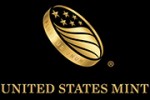 After a few years of playing with the look-and-feel of their website, the U.S. Mint is in the process of redesigning and reprogramming their online catalog.
After a few years of playing with the look-and-feel of their website, the U.S. Mint is in the process of redesigning and reprogramming their online catalog.
Face it, the U.S. Mint has not been the paragon of customer service. Their website and fulfillment process has been severely lacking. There were times when the site would crash after releasing high demand products including the limited edition American Eagle anniversary coins. Other than the re-skinning of the site, the U.S. Mint web presence has been a disaster.
Beginning in fiscal year 2014 (October 2013), the U.S. Mint awarded a contract to PFSweb to streamline fulfillment and re-design the web-based catalog and ordering service. The new website is due to be released at the beginning of fiscal year 2015 (October 2014). However, the impact of PFSweb has been felt with the better processing of online and telephone orders.
On September 9, the U.S. Mint released a video giving a preview of the new website. It maintains the color scheme the U.S. Mint has been using while adding flatter elements that have become the in-style of today’s website. According to the video, there will be a virtual tour coming soon. I will keep an eye out for that announcement.
In the mean time, here is the U.S. Mint video:
Here we go again: U.S. Mint fights collectors
The argument is over a 1974-D Lincoln cent made of aluminum that was to be auctions by Heritage Auctions during the April 2014 Central States Numismatic Society auction. Rather than being auctioned, the U.S. Mint requested its return as government property even though it was reported that no records of the coin’s production exist.
According to an updated report appearing in Coin World, the coin was given to Harry Lawrence, a former Denver mint assistant superintendent, as part of a retirement gift in 1979. Upon his death, his possession were willed to his son Randall Lawrence.
Randall Lawrence and Michael McConnell, a San Deigo-area dealer working with Lawrence, consigned the coin to Heritage in hopes to be able to donate at least $100,000 from the sale to charities helping the homeless in San Deigo. Heritage had estimated the coin to be worth $250,000. Lawrence and McConnell are asking the federal court to determine the coin’s ownership.
U.S. Mint does not have records of the aluminum cent being struck in Denver. There are records of 1 million coins struck in Philadelphia. Nearly all were destroy.
The U.S. Mint’s mishandling of their own records are legendary. Some of the more famous coins that have escaped official record include the 1933 Saint-Gaudens double eagle and the five 1913 Liberty Head nickels. Numismatic researcher Roger Burdette has documented significant gaps in the way the U.S. Mint has historically mishandled their own documents. Even in recent years, the U.S. Mint has played fast-and-loose even with required documentation during previous director’s term because the narrative of the annual report would make the U.S. Mint’s performance look less than stellar.
Unfortunately for the U.S. Mint, Coin World reporter Paul Gilkes was able to interview former Denver Mint employee Benito Martinez “who said he personally struck fewer than a dozen of these coins as a die setter on aluminum planchets provided by the Philadelphia Mint.” Martinez said that these coins eventually made its way to the U.S. Mint headquarters in Washington, D.C.
Aside from the bad precedent this would create for all pattern coins and trial strikes, this has the potential to undo whatever good will the U.S. Mint has built with the collecting public in the last few years. Problems with the Kennedy gold coin not withstanding, the work that the U.S. Mint has done after the departure of Director Edmund Moy to build a more collector-friendly can be undone by continuing this fight.
Maybe it is time that the lawyers at the U.S. Mint and the Department of the Treasury stop trying to flex its muscles and realize the goodwill that would be created by changing policies and attitudes. After all, like all lawyers it is possible to interpret the law in a manner that would be more helpful while protecting the U.S. Mint and the U.S. government.
ANA Responds to Kennedy Launch Fiasco
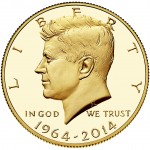 The American Numismatic Association issued a statement on August 28 about the 2014 World’s Fair of Money. As part of the statement, the fiasco of the Kennedy half-dollar gold coin was addressed.
The American Numismatic Association issued a statement on August 28 about the 2014 World’s Fair of Money. As part of the statement, the fiasco of the Kennedy half-dollar gold coin was addressed.
Before I add my commentary, I do not blame the ANA or the U.S. Mint for the problems at the Kennedy Half-Dollar gold tribute sales. The ANA, U.S. Mint and those responsible for security at the show site did what they could in order to make this a smooth process. As I have said in the past, I blame the dealers who were responsible for hiring the people who caused the problems.
Let’s look at the statement:
“When the U.S. Mint announced the sale of its dual-dated gold Kennedy commemorative coin at the World’s Fair of Money, the ANA was hopeful that the release of such a popular coin would be a boost to the hobby and increase public interest in numismatics,” said ANA Executive Director Kim Kiick. “Unfortunately, the challenges created by the mass of people trying to buy the coin became a concern for public safety, both at our show and at the U.S. Mint’s retail sites in Philadelphia, Denver and Washington, D.C.”
As I investigated further, there appears to have been less of a problem at the Washington, D.C. headquarters because the dealers involved hired actors to stand in line for them. Although the actors were not told what the “audition” was about, witnesses say that the actors were better behaved than the other line standers.
The image of the situation in Denver is haunting in regard to security. People lining up for a three-quarter ounce of gold that was selling for $1,240 and even more on the secondary market would make anyone nervous.
Public safety was the ANA’s top concern after the U.S. Mint announced that it would debut the coin at the World’s Fair of Money. Kiick commended the efforts of PPI Security, the staff of the Donald E. Stephens Convention Center, the Rosemont Police Department and ANA staff and volunteers for maintaining order. She also expressed disappointment that many of the coins were bought by people paid to stand in line.
Given the millions, if not billions of dollars in coins, currency, and other merchandise in the convention center, it is amazing that nothing else happened. Reports suggested that the crowd standing in line at the Stephens Convention Center were not collectors and their behavior was not what would be expected at an ANA show.
“The intent of the U.S. Mint was to sell its allotment of 2,500 coins to 2,500 different people, putting these coins into as many different hands as possible,” Kiick said. “The hiring of proxies to stand in line and receive the coin for somebody else not only went against the spirit of the sale, it hurt the ANA. The ANA is responsible for paying for extra security and damages to the exterior of the convention center brought on by these crowds.”
In an article by Dave Harper of Numismatic News, this is not the first time that this type of situation has occurred. Harper recalls the story by California dealer Ron Gillio who purchased 1968 proof sets in Denver using college students.
I had two thoughts after reading this. First, the dealers did not use college students in 2014 and placed them in an enclosed space at the World’s Fair of Money creating a situation where extra security was required. Second, to borrow a quote from my late mother, “two wrongs don’t make a right.” It was not the right thing to do at that time and it was not the right thing to do today.
While the U.S. Mint has announced that it plans to continue offering new coin releases at the World’s Fair of Money, Kiick said any future sales are contingent on whether the Mint and the ANA can put together a security and sales plan that will address the concerns raised from the Kennedy sales.
“We love having the U.S. Mint at all of our shows, and we certainly enjoy seeing the Mint bring exciting new products to the marketplace that will increase public interest in the hobby,” Kiick said. “However, the problems we experienced this year far outweigh the benefits. There will be no onsite sales in the future unless we can come up a new sales process to avoid the problems encountered at the various U.S. Mint sales locations.”
One way to control the sales at the ANA shows is to limit the sales to ANA members. ANA members have membership numbers and their membership information stored in an ANA database. If you are a member and want to purchase a newly released U.S. Mint product, you register with the ANA and receive a ticket. The ticket would be printed with your membership number and would identify you should something happen. The ticket would be non-transferrable.
Once the ticket is issued, it will be the responsibility of the member whose number is on the ticket to act in accordance with the ANA Code of Ethics. If the member transfers the ticket, the member remains responsible for the behavior of the person holding the ticket. If the ticket holder disrupts the proceedings, the member whom the ticket was issued to is responsible. That member would then be subject to appropriate disciplinary actions including legal action, if necessary.
Before anyone argues what is “right&rdqui; or “fairness,” the ANA can and should do what is in the best interest of the ANA. It is the ANA’s show and the ANA can run the show way it sees fit. If the ANA wants to limit access to members, as a membership-only organization, they can limit access to the bourse floor, even to the U.S. Mint.
If you do not like it, look at the video of what happened in Denver and blame the dealers who created this issue.


